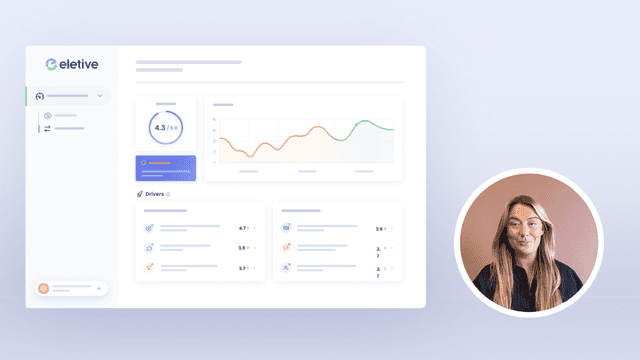AI is a true game-changer for employee engagement surveys, enabling even the largest of organisations to really listen to their people: in-depth, in real-time, and at scale.
Implementing AI for employee engagement can feel like venturing into uncharted territory.
The challenge? Understanding how to harness this technology effectively.
A common fear is that the introduction of AI might depersonalise the workplace, making employees feel more like data points than valued team members. But here's the twist...
If used correctly, AI for employee engagement can actually help businesses understand their people better and create a more human-centric work environment.
Before we show you what AI can do, you first need to understand the drawbacks of traditional employee feedback systems…
Challenges with traditional employee feedback systems
Gathering employee feedback is vital, yet traditional methods face numerous obstacles.
Obstacle 1 - information silos and lost responses
Information silos are instances where data or knowledge becomes confined to certain departments or teams, preventing its effective dissemination across the organisation.
In terms of systems like pulse surveys that collect employee feedback, these silos can lead to vital insights being lost in translation or completely overlooked.
Obstacle 2 - Importance and complexity of free-text answers
Handling free-text answers is vital for nuanced feedback.
Analysing vast text volumes is challenging; advanced tools are needed to avoid missing crucial details.
Global companies also face language complexities, translating while preserving sentiment.
Obstacle 3 - Bridging information gaps & capturing missed opportunities
Data isolation hinders access to crucial staff sentiment insights for culture improvement.
It’s also important to avoid lost responses and ensure valuable data isn't overlooked. Because this will boost engagement efforts.
The solution? Eletive’s Listening AI
In today's dynamic business landscape, understanding and responding to the needs and sentiments of employees has become more critical than ever.
Traditional methods of employee engagement and feedback collection are giving way to more advanced and insightful approaches.
We are proud to introduce our Listening AI feature. It truly listens to employees and extracts actionable insights.
This feature will help HR departments overcome the common obstacles listed in the previous section.
In this webinar, we sit down with our Enterprise Account Executive and Product Manager to discuss our feature Listening AI, and how AI and NLP can enhance employee surveys and make it easier to build workplaces where people thrive.
How to boost employee engagement with listening AI in 4 steps
Eletive's AI technology unfolds in stages, each revealing deeper insights.
Step 1: visualise insights: from overview to deep dive
The initial stage involves extracting significant topics from open-ended responses.
These topics are represented visually, with larger bubbles indicating greater prominence.
The colour-coded display provides insight into the emotional tone associated with each topic, enabling managers and leaders to prioritise areas of concern.
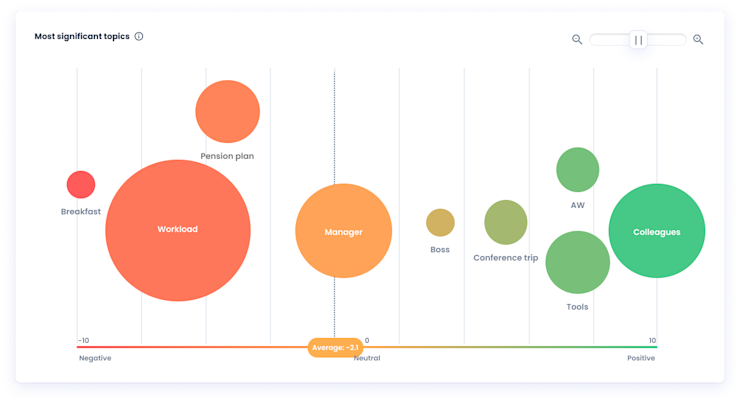
Step 2: segmented insights for targeted action
The AI technology further allows organisations to segment their employee feedback, shedding light on specific groups or demographics.
For example, you could analyse the sentiment among different segments such as "Females," "Denmark," and "UK."
By identifying the most prominent topics and emotional tones within these segments, you can tailor your strategies and interventions for maximum impact.
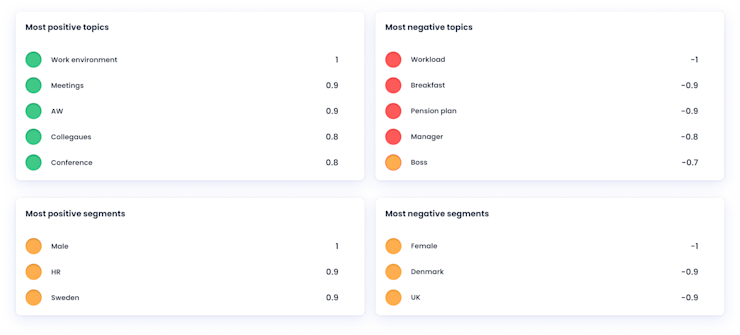
Step 3: dig deeper to address adjectives
At the heart of Eletive's AI technology lies the analysis of adjectives associated with prominent topics.
By examining how employees describe these topics, you can gain a deeper understanding of the underlying issues.
For instance, if "workload" is a prominent topic, delving into adjectives such as "unstructured" or "confusing" can illuminate specific pain points that need to be addressed.
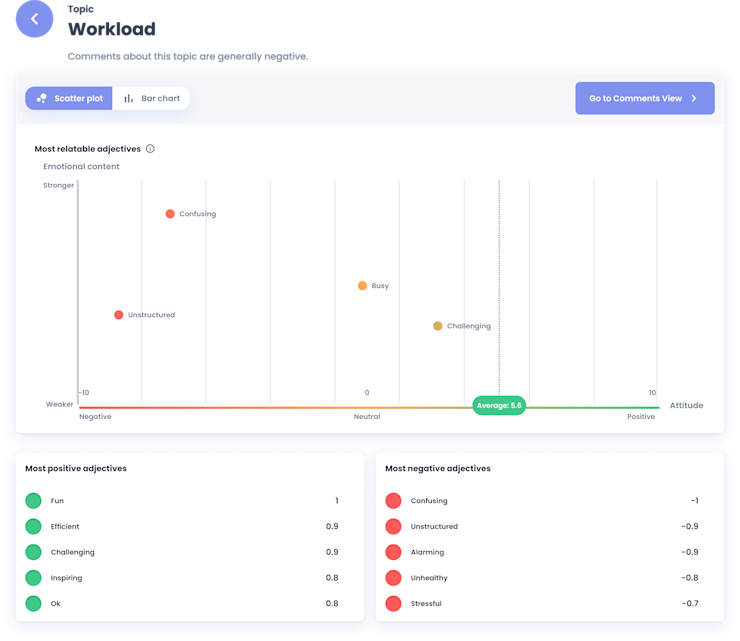
Step 4: from insights to action
The journey culminates in the deepest level of Eletive's AI technology, where organisations can explore source comments connected to specific topics and adjectives.
This granular view provides a wealth of information for actionable insights.
By understanding the distribution of positive, neutral, and negative comments, you can formulate strategies to enhance employee experience and well-being.
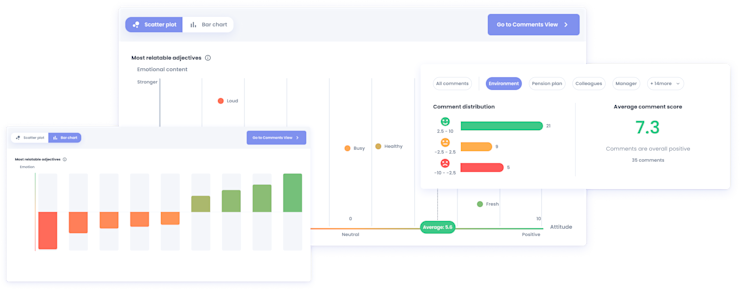
Eletive's AI technology stands as a game-changer in the realm of HR and employee listening.
By harnessing the power of AI to extract, analyse, and visualise employee feedback, you can make informed decisions, foster a culture of feedback, and create a workplace that thrives on continuous improvement.
This innovative approach offers a compelling path toward a more engaged, motivated, and fulfilled workforce. In addition to extracting and analysing feedback, the integration of AI text to video technology can further enhance employee engagement by transforming complex data into easily digestible visual formats. This allows HR departments to communicate insights more effectively across the organisation, making the information accessible and actionable for everyone involved.
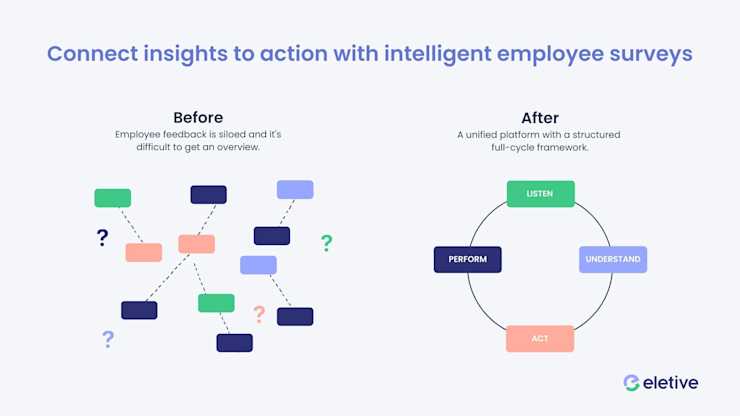
Eletive’s benefits
Cultivating feedback culture
Eletive's core mission is clear: "We help people build and improve feedback culture."
Boasting a database of over 9 million surveys, our unique emphasis on self-leadership sets us apart.
This empowers individuals and extends to all levels, from managers to organisational leadership.
Holistic empowerment
Eletive's approach extends beyond individuals to managers, teams, and top leadership.
You can develop self-leadership across all levels.
This comprehensive strategy cultivates an engaged and continuously improving workforce.
Related insights: Measuring Employee Engagement
Breaking language barriers with AI-powered multilingual support
We have language support for +40 languages in our product, and the listening AI takes care of them all.
This capability ensures that regardless of the language in which feedback is provided, Eletive's artificial intelligence technology steps in to bridge the linguistic gap.
The platform employs Natural Language Processing (NLP) analysis to translate and analyse inputs, allowing users to effortlessly switch between the original language and English translations.
Turning insights into tangible actions
The ability to glean insights from feedback in various languages extends beyond comprehension.
You can use this information when creating objectives, actions, one-on-ones, all the different follow-ups and actions, based on fact, based on what your people are writing about.
Eletive's multilingual support empowers HR managers and leaders to make well-informed decisions and design targeted strategies for organisational improvement.
Safety through inclusion
People are more comfortable when other people listen to their ideas, take them seriously, and include them.
It's super important as an employee to feel included within your organisation.
Inclusion is pivotal to nurturing a sense of belonging and psychological safety among employees, ultimately fostering a positive and engaged work environment.
Conclusion
AI for employee engagement is no longer a distant concept, but a tangible reality.
The power of AI in transforming the HR landscape is immense and undeniable.
From revolutionising employee surveys to breaking down language barriers, it's reshaping how businesses understand their people.
Eletive's Listening AI feature stands as an exemplar of this transformative journey.
Tackling traditional feedback system challenges head-on, it brings valuable insights right at your fingertips.
A full-cycle framework further empowers you to convert these insights into actionable strategies.
Ready to harness the potential of AI for boosting your team’s performance?
Dive into Eletive’s suite of tools designed specifically for measuring and increasing employee engagement and performance today!
Related reading: Listening Ai - Employee Listening at scale
Related reading: Pulse surveys in change management
Related reading: A guide to global employee engagement surveys in multiple languages
FAQs
How will AI impact employee experience?
AI is set to revolutionise the employee experience by automating repetitive tasks, facilitating seamless onboarding processes, personalising training programmes, and predicting future trends in workforce behaviour.
What is the role of artificial intelligence in employee engagement and retention?
The role of AI in enhancing engagement involves analysing data from various sources to understand employees' sentiments better. It helps identify areas for improvement that could boost morale and increase retention rates.
How does AI motivate employees?
By offering tailored development opportunities based on individual needs or preferences, AI motivates employees. It also promotes transparency through clear communication channels enabled by machine learning algorithms.










